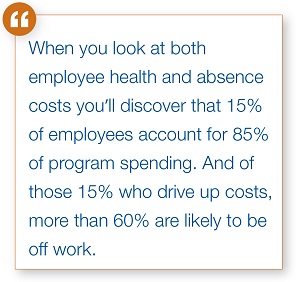*Excerpted from the HUB International ebook Absence Management in the Employee Lifecycle: Building a data-driven, integrated approach to improving health and productivity
High-performance companies need high-performing employees who have the right skills, are motivated and engaged, and want to be at work. But this workforce ideal doesn’t occur organically. Companies must create a 21st century absence management program to handle 21st century issues. Such a program includes best practices that reduce absenteeism, promote health, and bolster productivity.
Absence management programs are predicated on two rules: health and productivity are intertwined; and all lost time is connected. When you look at both employee health and absence costs you’ll discover that 15% of employees account for 85% of program spending. And of those 15% who drive up costs, more than 60% are likely to be off work. 
An effective Absence Management Program (AMP) can help identify, measure and address all employee absences, and create strategies and solutions to mitigate employee absence whether they are due to illness, injury, stress-related conditions, family-related issues, and/or a lack of engagement. Ultimately, an AMP can help cut direct and indirect costs of absenteeism, reduce the incidence of unscheduled absences, and promote a culture of health and productivity within your company.
Every year, a company spends significant dollars on chronic illness, medical, disability and lost time costs. An effective AMP must first recognize that health and productivity are interconnected. And on the other hand, an ineffective AMP can lead to mistakes and lack of compliance with federally-mandated programs such as the Family & Medical Leave Act and the Americans with Disabilities Act Amendments.
It is no wonder that employers today are looking for benefit plans and absence management strategies that support a culture of health and promote productivity. As research has shown, healthy behaviors translate into fewer health risks for employees, as well as lower prevalence of chronic conditions, reduced absenteeism, and higher performance while on the job.
An effective AMP is comprehensive and integrated across the employment lifecycle, from recruitment through development and promotion, with support for employee health and productivity at every stage. In this section we will look at some of the ways that absence management strategies can be applied to the employment lifecycle to achieve multiple workforce management goals.
Where to start?
- Establishing Recruiting Practices -- Hiring of people who are committed, engaged and a good match for the job is critical. These individuals are less likely to seek time off. When health issues or other circumstances result in unscheduled absences, they are highly motivated to return to work as quickly as possible.
- Focusing on Talent Management -- Encouraging employee development is essential to garnering greater performance. Talent management is not limited to employee development and/or succession planning. Rather, managing talent contributes to the organization’s overall objectives and provides opportunities to high-potential employees who are groomed for growth.
- Implementing Wellness – Wellness programs are another way to communicate commitment to employees and encourage healthy behaviors that translate into greater engagement in one’s life and work and, therefore, higher levels of productivity. There is growing evidence that wellness can help reduce the impact of chronic health conditions and the associated health care costs, which continue to rise as the workforce ages.
- Assuring Workplace Safety -- Safety and accident prevention identify and mitigate risks that could lead to a workers’ compensation claim. It is critical to encourage employees to embrace safety and health from the beginning, these initiatives should be part of new job orientation, education, and training.
- Managing Presenteeism -- When an employee comes to work but is not fully productive they cause “on the job slowdowns.” These productivity issues occur largely because of health conditions (for example, headaches, allergies, arthritis, and hypertension) as well as behavioral health issues, such as depression. Presenteeism can be of great consequence to employers because it is a less tangible and observable symptom of poor health.
A successful absence management program starts with a commitment to health and productivity, with the view that human capital truly is the company’s best asset. Download the complete ebook Absence Management in the Employee Lifecycle or contact your HUB Employee Benefits consultant to learn more about best-practice AMP solutions and recognize the importance of fostering health and promoting engagement across the employment lifecycle.